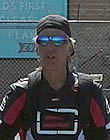|
|
This topic comprises 2 pages: 1 2
|
|
Author
|
Topic: Very tricky changeovers
|
|
|
|
|
|
|
|
|
|
|
|
|
|
|
|
|
|
|
Leo Enticknap
Film God

Posts: 7474
From: Loma Linda, CA
Registered: Jul 2000
|
 posted 02-10-2015 06:21 PM
posted 02-10-2015 06:21 PM





quote: Marcel Birgelen
But I think the editor is to blame here too. I guess you'll always want to have a changeover at a non-critical point in time, if remotely possible. Putting it in the middle of a line of dialog or in a moving shot just feels moronic or incompetent or both...
I'm wondering if the reel ends in this print were determined by the archive that made it rather than the original editor and/or negative cutter. Only one of the reels had negative lab cues - the rest were all Clint Phare-type scribed cues. It was also a 100-minute movie in five reels (it's very unusual for every reel of a feature print to be the full 20 minutes, especially from that era - 16-18 minutes is more common), and there was nitrate decomposition artifacting printed from the negative in one section. So I'm wondering if the source element from which this was printed was assembled from multiple sources itself, and that the person(s) assembling it simply didn't know what doing a manual changeover involves and therefore didn't give any thought to the positioning of the reel ends.
quote: Scott Norwood
Presumably, the assumption at the time was that no frames would be cut out of the print at the reel ends, so it would be possible to make frame accurate (or nearly so) changeovers.
Good point. After 2K reels became the norm in the mid-30s but before platters and towers, no-one would ever have needed to cut a leader or tail or leave ID frames, and so release prints would simply not ever have lost any frames from the start and end in normal use. For the picture changeover at least, the ramp-up speed of the motor on a given projector is an unchanging, known quantity, and so the operators at each theater would eventually work out what point in the leader to thread to such that the first frame of the action is in the gate when the over cue appears. Once you've done that, the accuracy of the change is limited only by the speed of the human reflex.
quote: Louis Bornwasser
Also, remember back in the 30s that sound changeovers were made with a big knob that had zero in the middle and volume on both sides. It was impossible not to fade down and then back up. This was physically large and coupled to at least one other knob with a shaft and gearing. There was a certain amount of inertia in this. Words would have been lost.
Wow! And I thought we were old fashioned, having separate picture and sound change buttons! In that case, no wonder the major studios liked to end their reels with a fade-out. It must have taken a lot of skill to do that and the pix change on the nail, unless the booths in those days were so lavishly staffed that there was a separate projectionist to change over the audio.
| IP: Logged
|
|
|
|
|
|
|
|
|
|
|
|
|
|
All times are Central (GMT -6:00)
|
This topic comprises 2 pages: 1 2
|
Powered by Infopop Corporation
UBB.classicTM
6.3.1.2
The Film-Tech Forums are designed for various members related to the cinema industry to express their opinions, viewpoints and testimonials on various products, services and events based upon speculation, personal knowledge and factual information through use, therefore all views represented here allow no liability upon the publishers of this web site and the owners of said views assume no liability for any ill will resulting from these postings. The posts made here are for educational as well as entertainment purposes and as such anyone viewing this portion of the website must accept these views as statements of the author of that opinion
and agrees to release the authors from any and all liability.
|

 Home
Home
 Products
Products
 Store
Store
 Forum
Forum
 Warehouse
Warehouse
 Contact Us
Contact Us




 Printer-friendly view of this topic
Printer-friendly view of this topic






![[Wink]](wink.gif) .
.




![[Razz]](tongue.gif)







